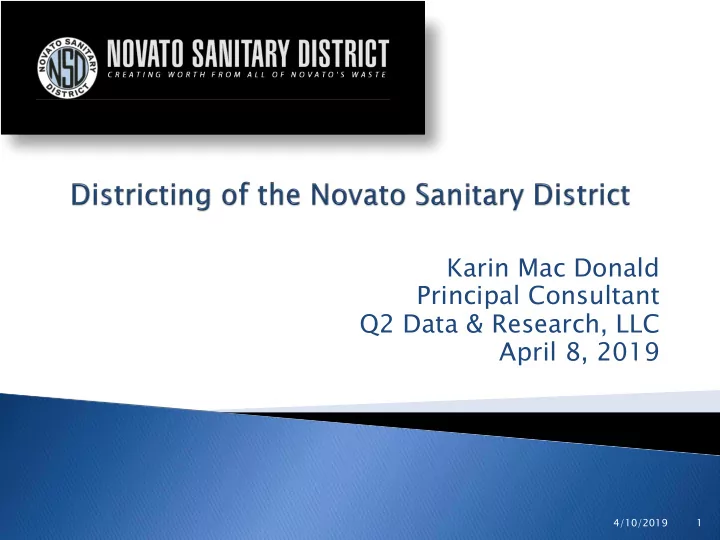

Karin Mac Donald Principal Consultant Q2 Data & Research, LLC April 8, 2019 4/10/2019 1
What is an at-large versus by-district 1) election system Criteria and Data 2) The Districting Process and Timeline 3) Participation by the public 4) 4/10/2019 2
At At-Lar arge e Elec ections ( s (current) ◦ In an at-large electoral system, all voters in the jurisdiction elect all representatives By By-Di Distr trict E t Electi tion ons ◦ In a district-based electoral system, representatives are elected from districts (“zones”), by the voters that live in each district. ◦ Candidates must reside in the district or zone they represent. ◦ Districting is the process of drawing the boundaries that divide the NSD’s population into five districts (zones). 4/10/2019 3
Districting Criteria ◦ Constitution ◦ Statute ◦ “Traditional” Data to create Districts or Zones Census ◦ American Community Survey ◦ Public Input ◦ What will the districting process look like? 4/10/2019 4
5 criteria used for drawing districts or zones 1. Equal Population 2. Compliance with Federal Voting Rights Act (FVRA) 3. Contiguity 4. Compactness 5. Respect for Communities of Interest 4/10/2019 5
“One person, one vote” U.S. Constitution requires districts (zones) have “reasonably equal” populations. Some deviation above/below “ideal” is allowed (~5%) 14th Amendment Intentional discrimination is prohibited (Equal Protection). 15 th Amendment Bans racial discrimination in voting. 4/10/2019 6
Ideal = Total population / Number of Zones Population numbers are based on the most recent Census Everyone who was counted by the census will be assigned to a district Zones are built using the total population, not voters, citizens or other subgroups 4/10/2019 7
Prohibits the denial or abridgement of voting rights on the basis of race or language minority status . ◦ FVRA defines Language minority as Asian, Native American, Alaskan Native, or Spanish heritage Prohibits practices that have the purpose or effect of discriminating on the basis of race or language minority status. Applies nationwide to all jurisdictions that conduct elections. 4/10/2019 8
Electoral systems can limit the “ability to elect a candidate of choice” by a protected class of voters in various ways: ◦ Example: at-large election systems can make it impossible for even a large minority group to elect a candidate of choice, when the majority votes against them. ◦ Example: single-member districts can be drawn in ways that minimize voters’ ability to elect a candidate of choice. Systems that limit ability to elect in this way are said to “dilute” minority voting strength. 4/10/2019 9
A districting plan can dilute minority voting strength through two main ways: “Cracking” ◦ Dividing up a politically viable population concentration so it doesn’t constitute a majority in any district or zone. “Packing” ◦ Drawing high proportion minority population into one district or zone when it could be politically viable in more than one district 4/10/2019 10
Supreme Court opinions have limited the role that race can play in districting Race cannot be the predominant criterion in line drawing Race should not subjugate “traditional districting principles” (Compactness, Contiguity, Communities of Interest) District appearance has been important in some cases. 4/10/2019 11
A geographic Criterion Definition: A contiguous district is one in which all parts are connected to each other In other words: A district or zone in which one may travel from any location to any other location without crossing the district boundary 4/10/2019 12
Addresses the geography of the district or zone Many different ways to measure Assumed to “guard against all types of gerrymandering” “drastic departures from compactness are a signal that something may be amiss” Most common complaints come from appearances: ◦ Does a district or zone look funny? ◦ “eyeball approach” “appearances do matter” 4/10/2019 13
A Community of Interest (COI) generally refers to a contiguous population that shares social or economic interests ◦ Examples Schools, culture, transportation, parks Shared goals of improving parks, safety, historic resources Employment or lack of thereof and economic opportunities Neighborhoods may be Communities of Interest ◦ Law does not limit the kinds of interests that may bind a community Communities of Interest are not Districts (zones): Frequently smaller; may be used as building blocks to construct ◦ districts No datasets available: defined by public input – YOU! 4/10/2019 14
Initial Hearings ◦ 2 Hearings before line drawing begins Collection of public input Construction of Map(s) Publicizing the Draft Map Feedback Hearings ◦ 2 Hearings to collect feedback on a draft map Hearing to adopt the ordinance Outreach – Collaboration - Participation 4/10/2019 15
Board adopted Resolution of Intent to transition Monday, April 1 from at-large to by-district elections Monday, April 8 1st Public Hearing (Regular Meeting) Monday, April 15 2nd Public Hearing (Special Meeting) By Monday, April 29 Publish draft map(s) Monday, May 6 3rd Public Hearing (Special Meeting) Adjustments of Draft maps live • Publication of any new or amended district maps • and potential sequence of elections. 4th Public Hearing (Special Meeting) Tuesday, May 28 Possible Adjustments of Draft maps live • Publication of new or amended district maps (if • applicable) and potential sequence of elections Monday, June 10 5th Public Hearing (Regular Meeting) Adoption of new District Boundaries • 4/10/2019 16
Why? To make sure we know about Communities of Interest. ◦ To give communities a voice and make sure they have ◦ equal access to the political process. To help shape a districting plan that provides ◦ communities a meaningful opportunity to elect candidates who represent their interests on issues that are important to their lives. How? Testify, submit written testimony, send supporting ◦ information to the district Stay informed – Our Website: http://www.novatosan.com (click on District Elections) 4/10/2019 17
4/10/2019 18
Recommend
More recommend